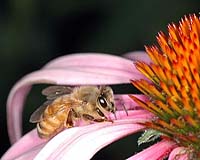 |
Kagawa, Japan (SPX) Apr 29, 2010 Growing tomatoes is not always easy. In many parts of the world summers are too hot to grow tomatoes in greenhouses, even those with intricate cooling systems. In cooler climates where tomatoes are grown year-round in production greenhouses, yield fluctuations are still challenging for producers who need to fulfill orders and predict labor costs. Finding accurate methods for predicting greenhouse tomato yields is at the forefront of growers' concerns. A new research study may take the speculation out of yield predictions and offer help for tomato producers. Tadahisa Higashide, a scientist at Japan's National Agricultural and Food Research Organization, published the study in a recent issue of HortScience. The research indicated that fluctuations in fruit number and yield under greenhouse conditions could be predicted on the basis of fluctuations in solar radiation. According to the Higashide, development of an accurate method to predict weekly fluctuation in tomato yield, especially during summer, is still a big challenge; tomato yields fluctuate almost simultaneously in many fields in an area, although growers, greenhouses, plant growth stages, and crop management differ. Yield fluctuations can cause prices to fluctuate, purchasers to look to competing suppliers, and inadequate distributions of labor-complications that have an impact on revenues and consumer satisfaction. Accurate prediction of yield fluctuations would help growers revamp their marketing approaches (e.g., cooperative shipping with a grower in another area to fill supply gaps) or implement environmental controls in their greenhouses. The study was designed to develop a method for predicting fluctuations in weekly tomato yield under high temperatures. Higashide investigated the relationships between environmental data and tomato yield and whether these relationships could be used to predict yield fluctuations. The experiments were conducted using the popular Japanese tomato cultivar 'Momotaro 8' grown in two commercial "sloped" greenhouses in Higashimiyoshi, Tokushima, Japan. Fluctuations in yield were caused mainly by the variation in fruit number rather than fruit weight. "The number of harvested fruit and the yield of plants grown in summer and fall were significantly and positively correlated with solar radiation during the days before anthesis (the period during which a flower is fully open or in full bloom)", stated Higashide. Although the fruit number and yield were also significantly correlated with air temperature before anthesis, the correlations were weaker than the correlations with solar radiation. There was no significant correlation between the air temperature in the periods encompassing 3 weeks before harvesting and the fruit number and yield. Therefore, fluctuations in fruit number and yield could be predicted by a model based on the solar radiation from 4 to 10 days before anthesis. Higashide summarized the experiment's outcomes, noting that fluctuations in the weekly fruit number and yield for tomatoes grown in greenhouses during the summer and fall were strongly and significantly correlated with fluctuations in solar radiation during the periods encompassing 12 to 0 days before anthesis. "On the basis of fluctuations in solar radiation, fluctuations in fruit number and yield under these conditions could be predicted. Thus, solar radiation at the period before anthesis was one of the important factors in prediction of tomato yield under warm greenhouse conditions."
Share This Article With Planet Earth
Related Links American Society for Horticultural Science Farming Today - Suppliers and Technology
 No single cause for mass die off of honey bees: OIE
No single cause for mass die off of honey bees: OIEParis (AFP) April 28, 2010 The huge die off of bees worldwide, a major threat to crops depending on the honey-making insects for pollination, is not due to any one single factor, the World Organisation for Animal Health (OIE) said Wednesday. Parasites, viral and bacterial infections, pesticides, and poor nutrition resulting from the impact of human activities on the environment have all played a role in the decline, t ... read more |
|
| The content herein, unless otherwise known to be public domain, are Copyright 1995-2010 - SpaceDaily. AFP and UPI Wire Stories are copyright Agence France-Presse and United Press International. ESA Portal Reports are copyright European Space Agency. All NASA sourced material is public domain. Additional copyrights may apply in whole or part to other bona fide parties. Advertising does not imply endorsement,agreement or approval of any opinions, statements or information provided by SpaceDaily on any Web page published or hosted by SpaceDaily. Privacy Statement |